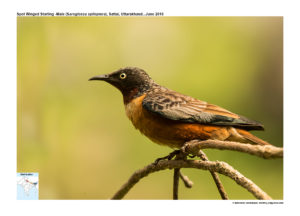
Spot-winged Starling Saroglossa spiloptera
Etymology:
- Saroglossa : Greek word saron- broom; glossa – tongue
- Spiloptera : Greek word spilos- spot; pteros-winged
Vernacular names: U.P.: Puli
Distribution in India:Summer visitor in Northern Himalayan foothills, passage migrant in central Himalayan foothills and winter visitor in North East.
Description: Size of 18-19 cm. It is a small, mostly brownish starling with pale eyes. The male has feathers of crown to mantle and back grey with dark borders, rump red-brown; wing is blackish with olive sheen, white patch near base of each primary. The tail is dark rufous-brown; side of head grey, chin and throat are dark red-brown. The underparts are variably chestnut-brown, often pale on chest, pale feather edges in center of belly, thighs are grey; iris is white to pale yellow; bill is black, brown base; legs are dark brown. The female has crown, nape and upperparts grey-brown with pale spot-like areas on feathers, wings and tail dark brown, chin, throat and chest pale brown with dark central streaks, flanks, belly and under tail-coverts dull white.The juvenile resembles female but with more streaking below, brown wash on flanks, brown tips on wing-coverts, iris is dark brown to grey.
Habitat: It is found in open forest, clearings and forest edge in hilly country.
Food Habits: It is omnivorous. The diet includes fruit, insects and nectar.Fruit taken include figs and berries. Insect eaten in mainly red ants and winged termites. It forages mainly in canopy
Breeding Habits: They breed in Feb-May in Southern Parts of India. They are monogamous. They nest in natural tree hole above ground, cavity lined with green leaves and other material. They lay a clutch of 3–4 eggs. The incubation is done by both sexes, female doing more for a period 13 day. Both parents feed chicks and remove faecal material. The nestling period is for 20–22 days.